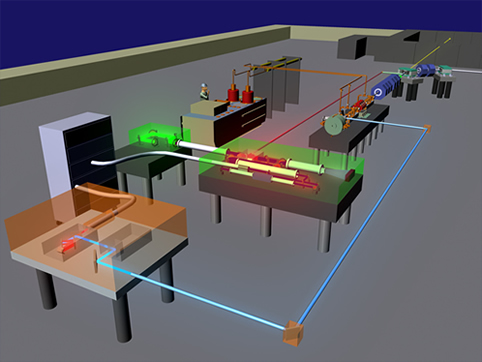By James Van Howe
 From LLNL, Artist's concept of the MEGa-ray system
From LLNL, Artist's concept of the MEGa-ray system
This post originally appeared on Jim’s Cleo Blog and is reproduced with permission from its author.
The conference program for CLEO 2011 was just released on Wednesday, March 2. Among many other cutting-edge and ground-breaking contributed papers are those from the new conference to debut this May, CLEO: Applications and Technology. Browsing the topic subcategory, Lasers for Government Science and Security Applications, I came across titles that seemed to be the stuff out of a James Bond movie, ATuF2, “Mono-Energetic Gamma-rays (MEGa-rays) and the Dawn of Nuclear Photonics” and ATuF4, “2D+3D Face Imaging for Stand-off Biometric Identification.” Can’t you just picture the mad, evil-scientist-villain (disfigured in some way, stroking his cat) plotting to steal a MEGa-Ray device in one scene, and Q 3D-scanning 007′s face in order for him to gain access into MI6 in another? Maybe I need to do more optics research and watch less movies, however, there’s no question about impact of these papers.
Last February, David Gibson, Christopher Barty and colleagues at the National Ignition Facility and Photon Science Division at Lawrence Livermore National Laboratory (LLNL) published their initial results on a MEGa-Ray source they constructed as groundwork for a beefier machine (2 MeV) in the future. At 2 MeV, such a narrow-bandwidth, high-energy, x-ray source could provide brightness 15 orders of magnitude greater than those produced by synchotrons. The artist rendition of the facility shown in the figure above demonstrates the compact size (a large room) compared to the kilometer-scale rings or linacs conventionally used for generating x-ray beams. Additionally, x-rays of this energy and brightness will find use in nuclear physics and applications such as detection of concealed nuclear material or specific isotope detection and quantification.
Brian Redman from Lockheed Martin and his collaborators, on the other hand, are using light in a very different way- to scan human faces for secure identification and threat-detection. Biometric identification refers to a technique in which a subject can be identified by a unique physical trait or something they physically produce. Some examples are fingerprinting, iris scans, facial scans, and analysis of gait.
One of Lockheed’s specific objectives in their partnership with the FBI is to build a database of facial scans analogous to their database of fingerprints, the Integrated Automated Fingerprint Identification System (IAFIS). I look forward to hearing how Dr. Redman’s CLEO talk addresses the optics involved in the facial scans, the use of both 2D and 3D scan information, and the success of the algorithms employed..for the full post click here.
Posted: 4 March 2011 by
James Van Howe
| with 0 comments